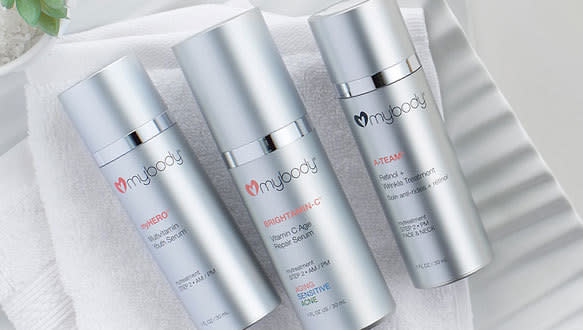The Newest Probiotic Science and What it Means For Skin Care
When we tell you that probiotics belong on your face, a natural first reaction is full-blown skepticism. You’ve read the news: you know all about fermented foods, probiotic supplements, and how these foods are linked to better health, including magnificent skin. But you’re supposed to eat them, right? Absolutely! But there’s more to probiotics than you thought.
More from CHARLOTTESBOOK.COM:
Fermented Foods Help You Lose Weight + Give You A Healthy Gut
Innovative New Treatments In Aesthetic Dermatology
Reduce Inflammation With These Ten Foods

Let’s start with a quick review of bacteria, because that’s the key here—that ever-changing collection called your microbiome.
Your mood is influenced by bacteria roaming your intestines, suggested the New York Times; joint pain might be caused by them too, said The Atlantic. Bacteria are a big deal, declared The New Yorker, and we don’t even know what they do yet. Yeah, agreed the Boston Globe, we have no clue what’s going on. Vogue extolled the benefits of kefir for skin health and weight loss; Charlotte’s Book agrees, and we also wrote about the incredible link between gut bacteria and rosacea.
So when you hear the latest in bacteria-based research and what it can do for your skin, on your skin, it might sound bizarre, but it makes a lot of sense.
What Exactly Are Topical Probiotics?
Your daily consideration of bacteria on your skin might be limited to a hasty application of hand sanitizer. In fact, your skin is (of course) covered in a variety of busy bacteria. The theory behind putting probiotics on your skin—topical probiotics—is that we should work with these bacteria and their complex defense systems to do the usual skincare magic: reduce inflammation, improve texture, build collagen, and yes, produce that glow.
How Does It Work?
The first thing to understand is that you are not applying anything fermented, or even bacteria, to your skin. In that sense, the term topical probiotics is slightly misleading. Bottling, transporting, and using live fermented ingredients could result in a temperamental product, and guaranteeing specific results wouldn’t be possible because there are so many variables. To create a stable product backed by DNA-testing, the probiotic strains are standardized and recreated in a lab: the bacteria-like molecule is born.
How Are These Molecules Created, And What Do They Do?
Dr. Doris Day, a Charlotte’s Book Premiere Provider and cosmetic dermatologist practicing at Day Dermatology and Aesthetics in New York, explained to us how this molecule is created: “Live strains [of bacteria] are put through fermentation, which then release secondary molecules that are collectively known as Probiotic Derived Bioactives (PDBs). It is these molecules that have been put through the clinical testing to prove they mimic the action of live bacteria, in a more controlled environment, all while being stable.”
Day is on the advisory board of mybody skincare, a physician-inspired skincare line that launched about five years ago by David Watson (the founder of BioMedic and Philosophy). The company’s newest release is called GLOWBIOTICS, a line that exemplifies the forefront of probiotic science in skincare (we love their new GLOWBIOTICS Probiotic Resurfacing Pads).
The probiotic derivatives Dr. Day describes (PDBs) are what stimulate the immune response in our skin: they connect with receptors which “initiate different microbiological cellular processes that may include stimulating protein production,” explains Dr. Bernard Raskin, mybody skincare’s medical director.
Yes, bacteria can also stimulate the inflammatory response you recognize as acne or rosacea, but GLOWBIOTICS has tested and uses non-inflammatory elements that spur the skin’s natural immune defense system in a positive way, thereby building additional surface skin cells. “In clinical studies,” explains Dr. Day, “PDB’s have proven to stimulate genes in the skin related to hydration, barrier repair, collagen synthesis and anti-inflammatory properties. This leaves the skin looking smoother, more hydrated, with less redness and fewer lines and wrinkles.” That’s exactly what we’re looking for.
Sounds Great. But Why Not Just Use Yogurt?
While the term “probiotic” has been popping up on products over the last several years, mybody and Aurelia Skincare are two lines now fully based on probiotic science, whereas others rely on yogurt extract and other elements to produce results.
Dr. Raskin reminded us that “Cleopatra enhanced her beauty by bathing in sour (fermented) milk,” but science has advanced, and so should we. “Putting yogurt on your skin won’t work because the bacteria are too big to pass into the skin. Plus it’s messy. Only tiny particles can be absorbed into skin—that’s a limiting factor in all cosmeceuticals.”
What Products Are Best? How Do They Differ?
Remember that not all products dubbed “probiotic” are doing the same thing, or even contain the same active ingredients. Do your homework.
Dr. Erin Gilbert, a Brooklyn-based Dermatologist and a member of the mybody advisory board, told us that “the type of bacteria used to create each product differs, but the overall goal is to populate the skin with ‘good’ bacteria that help create the best overall skin balance.” Gilbert adds, “products also differ in the other ingredients they incorporate that benefit the skin’s appearance, such as hydrators like hyaluronic acid or smoothing acids like Alpha Hydroxy Acids.”
Are Topical Probiotics Just Another Trend?
Admittedly, probiotics are trendy. But bacteria are decidedly not trendy, and their benefits (and complications) aren’t going anywhere.
“Since we are still in the early days of understanding all of the benefits of probiotics in skincare,” explained Dr. Gilbert, “I expect that we will see products developed over the coming years that target skin concerns in a more precise way. Based on the research conducted so far, I expect that we will see a lot more products designed to treat acne, rosacea and eczema as well as other skin conditions where bacterial imbalance are among the major causes.”
We can’t wait to see what happens.
